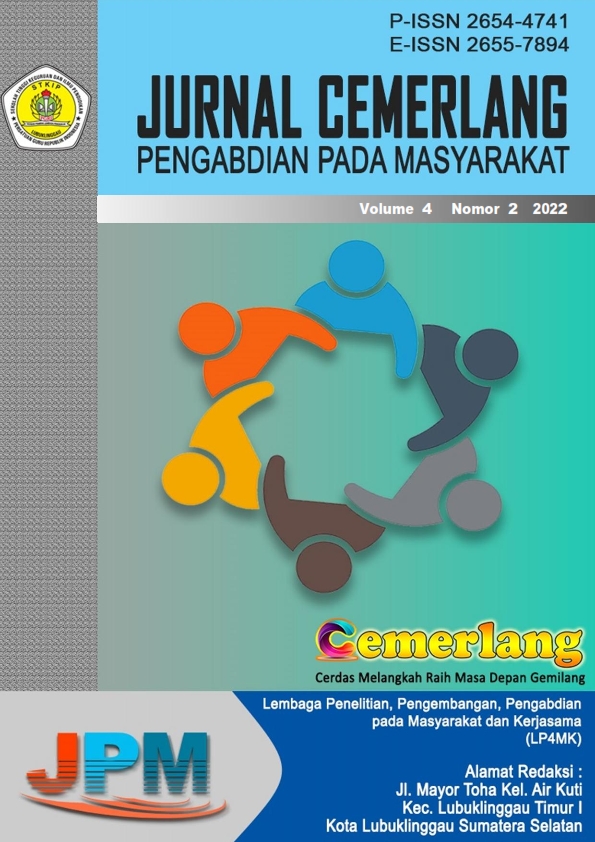PEMANFAATAN SERABUT KELAPA (COCOFIBER) MENJADI KOKEDAMA SEBAGAI PELUANG BISNIS DI MASA PANDEMI COVID 19
Abstrak
Tujuan pelatihan ini adalah meningkatkan keterampilan kreativitas masyarakat dalam memanfaatkan serabut kelapa menjadi kokedama, sehingga dapat dijadikan peluang bisnis di masa pandemi covid 19. Pelaksanaan kegiatan ini di salah satu rumah warga Rukun Tetangga (RT) 12 Kelurahan Jalan Gedang Kecamatan Jalan Gedang Kota Bengkulu. Metode kegiatan ini dengan cara pemberian penyuluhan, pelatihan, dan pendampingan tentang pembuatan kokedama. Hasil dari kegiatan ini masyarakat yang ada di RT. 12 Kelurahan jalan Gedang mendapat ilmu baru tentang bagaimana cara membuat kokedama dengan memanfaatkan serabut kelapa sebagai pengganti media pot. Hasil yang didapatkan dari proses pengabdian masyarakat ini respons masyarakat yang sangat positif dan antusias dalam proses sosialisasi, praktik, dan pendampingan. Rekomendasinya diharapkan kegiatan pemanfaatan serabut kelapa menjadi kokedama ini semakin dikembangkan dimasyarakat dalam cakupan yang lebih besar sebagai peluang bisnis dan penambah penghasilan perekonomian masyarakat.
Referensi
Badan Penelitian dan Pengembangan Pertanian. (2019). Pemanfaatan Sabut Kelapa sebagai Sumber Kalium Organik. Online https://www.litbang.pertanian.go.id/info-teknologi/3043/ diakses 16 September 2021
Badan Riset dan Inovasi Nasional. (2021). Tanaman Hias dan Peluang Inovasi di Masa Pandemi. Online https://www.brin.go.id/tanaman-hias-dan-peluang-inovasi-di-masa-pandemi/ diakses 2 November 2021.
Garneti, A. E. (2017). Analisis Strategi Pemasaran dalam Upaya Peningkatan Volume Penjualan Tanaman Hias Boneka Lumut dengan Media Tanam Kokedama pada UMKM Planter Craft Bandung. In Skripsi diterbitkan. Universitas Brawijaya.
Hanum, M. S. (2015). Eksplorasi Limbah Serabut Kelapa (Studi Kasus: Desa Handapherang Kecamatan Cijeunjing Kabupaten Ciamis). E-Proceeding of Art and Design, 2(2), 932.
Indahyani, T. (2011). Pemanfaatan Limbah Serabut Kelapa pada Perencanaan Interior dan Furniture yang Berdampak pada Pemberdayaan Masyarakat Miskin. Humaniora, 2(1), 15.
Melati, R., Basri, A., & Sabban, H. (2019). Workshop dan demonstrasi bagi mahasiswa kubernas dalam memanfaatkan limba organik dan anorganik. Jurnal Pengembangan Masyarakat Loka, 2(2), 2–6.
Saputra, N. E., Hernanda, H. B., Nurhuda, N., Ridwan, F. N., & Ardhi, M. W. (2019). Pelatihan Bioentrepreneurship melalui Pembuatan Kokedama di Panti Asuhan Anak Luar Biasa Asih Madiun. CARADDE: Jurnal Pengabdian Kepada Masyarakat, 2(1), 101–104.
Suyoto, B. (2008). Rumah Tangga Peduli Lingkungan. Prima Media, Jakarta
Toyoda, M., Yokota, Y., Barnes, M., & Kaneko, M. (2020). Potential of a Small Indoor Plant on the Desk for Reducing Office Workers’ Stress. Hort Technology, 30(1),
Thomson, D. (2016). Kokedama–The Japanese String Gardens. http://www.medium.com (diakses pada 11 Juni 2021)
Trahutami, S. & Wiyatasari, R. (2019). Pengenalan dan Pelatihan Penanaman dengan Teknik Kokedama Untuk Ibu-Ibu PKK. Harmoni, 3(2), 36–39.

Jurnal Pengabdian Masyarakat by http://ojs.stkippgri-lubuklinggau.ac.id/index.php/JPM is licensed under a Creative Commons Attribution-ShareAlike 4.0 International License.













